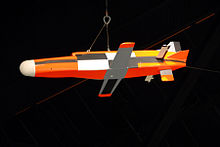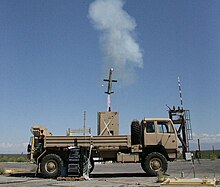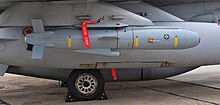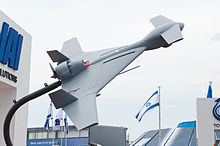Loitering munition
[19][20] In the 1980s, a number of programs, such as the IAI Harpy or the AGM-136 Tacit Rainbow, integrated anti-radiation sensors into a drone or missile air frames coupled with command and control and loitering capabilities.This integrated the use of a drone as a baiting decoy with the attack role into one small and relatively cheap platform in comparison to the alternative wild weasel jet fighter.Explosive ordnance such as an IED, grenade, mortar round or an RPG warhead are fitted to an FPV drone then deployed to aerial bomb tactical targets.[34] On 9 November 2023, Ukrainian soldiers claimed to have used a civilian-donated FPV drone to destroy a Russian Tor missile system on the Kupiansk front, showcasing the potential cost-effectiveness of fielding such munitions.[37] Purpose-built munitions are more elaborate in flight and control capabilities, warhead size and design, and onboard sensors for locating targets.[41][42] Some loitering munitions may return and be recovered by the operator if they are unused in an attack and have enough fuel; in particular this is characteristic of UAVs with a secondary explosive capability.Since spring 2022 Ukrainian forces have been building cages around their artillery pieces using chain link fencing, wire mesh and even wooden logs as part of the construction."[citation needed] A picture supposedly taken from January 2023 shows the rear half of a Lancet drone that failed to detonate due to such cages.[60][61][62] On 21 March 2024, recent footage of the submarine Tula showed that it has been fitted with a slat armor to prevent drone strikes, the first ocean-going asset to carry such a modification.Cruise missiles, as their name implies, are optimized for long-range flight at constant speed both in terms of propulsion systems and wings or lifting body design.[70][71] Loitering munitions that are capable of making autonomous attack decisions (man out of the loop) raise moral, ethical, and international humanitarian law concerns because a human being is not involved in making the actual decision to attack and potentially kill humans, as is the case with fire-and-forget missiles in common use since the 1960s.








Unmanned combat aerial vehicleoutlineHistoryPrehistoricAncientPost-classicalCastlesEarly modernMilitary revolutionPike and shotNapoleonic warfareLate modernIndustrial warfareFourth-gen warfareMilitaryOrganizationCommand and controlDefense ministryAir forceMarinesCoast guardSpace forceReservesEngineersMedicalPoliceDivingInfantryCavalryArtillerySpecial forcesSignal corpsWarshipsSubmarinesAircraft carriersLanding craftAuxiliary shipsFightersBombersCommandClose air supportElectronic-warfareReconnaissanceFire-control systemFire-control radarDirector (military)Combat information centerShip gun fire-controlGun data computerTorpedo data computerBasic trainingMilitary manoeuvrersCombat trainingBattlespaceAerospaceAerialAirborneCold-regionDesertFortificationJungleMountainSubterraneanTunnelAmphibiousSurfaceUnderwaterSeabedInformationWeaponsAir defenceBarrageBiologicalCamouflageHorsesChemicalCombined armsConventionalDenialDisinformationElectromagneticMissileNuclearPsychologicalRadiologicalSubmarineUnconventionalTacticsList of military tacticsAirliftAir assaultAirbridgeAirdropAnti-aircraftAnti-subAnti-tankBattleChargeCounterattackCounterinsurgencyConvoyDefeat in detailFoxholeEnvelopmentFormationGuerrillaRapid dominanceEncirclementInvestmentScreenTactical objectiveTarget saturationTrenchWithdrawalOperationalMilitary operationSpecialOperations researchBlitzkriegExpeditionaryDeep operationManeuverOperational manoeuvre groupCovertStay-behindStrategy